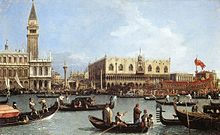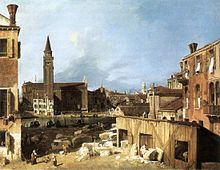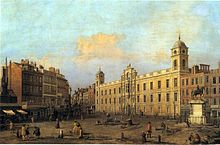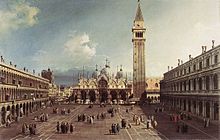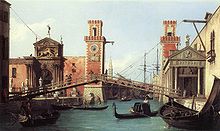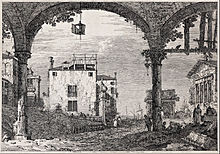
Canaletto
About this schools Wikipedia selection
This selection is made for schools by a children's charity read more. See http://www.soschildren.org/sponsor-a-child to find out about child sponsorship.
| Canaletto | |
|---|---|
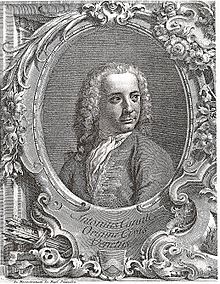 |
|
| Birth name | Giovanni Antonio Canal |
| Born | 17 October 1697 Venice |
| Died | 19 April 1768 (aged 70) Venice |
| Nationality | Italian |
| Field | Landscape art, etching |
| Training | Luca Carlevaris |
| Patrons | Owen Swiny Joseph Smith |
| Influenced by | Giovanni Paolo Pannini |
| Influenced | Bernardo Bellotto |
Giovanni Antonio Canal (17 or 18 October 1697 – 19 April 1768) better known as Canaletto (Italian: [kanaˈletto]), was an Italian painter of landscapes, or vedute, of Venice. He was also an important printmaker in etching.
Early career
He was born in Venice as the son of the painter Bernardo Canal, hence his mononym Canaletto ("little Canal"), and Artemisia Barbieri. Bernardo Bellotto was his nephew and pupil. Canaletto served his apprenticeship with his father and his brother. He began in his father's occupation, that of a theatrical scene painter. Canaletto was inspired by the Roman vedutista Giovanni Paolo Pannini, and started painting the daily life of the city and its people.
After returning from Rome in 1719, he began painting in his topographical style. His first known signed and dated work is Architectural Capriccio (1723, Milan, in a private collection). Studying with the older Luca Carlevarijs, a moderately-talented painter of urban cityscapes, he rapidly became his master's equal.
In 1725, the painter Alessandro Marchesini, who was also the buyer for the Lucchese art collector Stefano Conti had inquired about buying two more 'views of Venice', when the agent informed him to consider instead the work of "Antonio Canale... it is like Carlevaris, but you can see the sun shining in it."
Outdoor painting
Much of Canaletto's early artwork was painted "from nature", differing from the then customary practice of completing paintings in the studio. Some of his later works do revert to this custom, as suggested by the tendency for distant figures to be painted as blobs of colour - an effect produced by using a camera obscura, which blurs farther-away objects.
However, his paintings are always notable for their accuracy: he recorded the seasonal submerging of Venice in water and ice.
Early and late work
Canaletto's early works remain his most coveted and, according to many authorities, his best. One of his early pieces is The Stonemason's Yard (1729, London, the National Gallery) which depicts a humble working area of the city.
Later Canaletto painted grand scenes of the canals of Venice and the Doge's Palace. His large-scale landscapes portrayed the city's pageantry and waning traditions, making innovative use of atmospheric effects and strong local colors. For these qualities, his works may be said to have anticipated Impressionism.
Work in England
Many of his pictures were sold to Englishmen on their Grand Tour, often through the agency of the merchant Joseph Smith (who was later appointed British Consul in Venice in 1744).
It was Smith who acted as an agent for Canaletto, first in requesting paintings of Venice from the painter in the early 1720s and helping him to sell his paintings to other Englishmen.
In the 1740s Canaletto's market was disrupted when the War of the Austrian Succession led to a reduction in the number of British visitors to Venice. Smith also arranged for the publication of a series of etchings of "capricci" (or architectural phantasies) ( capriccio Italian for fancy) in his vedute ideale, but the returns were not high enough, and in 1746 Canaletto moved to London, to be closer to his market.
He remained in England until 1755, producing views of London (including the new Westminster Bridge) and of his patrons' castles and houses. His 1754 painting of Old Walton Bridge includes an image of Canaletto himself.
He was often expected to paint England in the fashion with which he had painted his native city. Overall this period was not satisfactory, owing mostly to the declining quality of Canaletto's work. Canaletto's painting began to suffer from repetitiveness, losing its fluidity, and becoming mechanical to the point that the English art critic George Vertue suggested that the man painting under the name 'Canaletto' was an impostor.
The artist was compelled to give public painting demonstrations in order to refute this claim; however, his reputation never fully recovered in his lifetime.
After his return to Venice, Canaletto was elected to the Venetian Academy in 1763. He continued to paint until his death in 1768. In his later years he often worked from old sketches, but he sometimes produced surprising new compositions. He was willing to make subtle alternations to topography for artistic effect.
Market
His pupils included his nephew Bernardo Bellotto, Francesco Guardi, Michele Marieschi, Gabriele Bella, and Giuseppe Moretti. The painter, Giuseppe Bernardino Bison was a follower of his style.
Joseph Smith sold much of his collection to George III, creating the bulk of the large collection of works by Canaletto owned by the Royal Collection. There are many examples of his work in other British collections, including several (19) at the Wallace Collection and a set of 24 in the dining room at Woburn Abbey. A large set of Canaletto works was also part of the collection of the Earls of Carlisle, however many were lost at the 1940 fire of Castle Howard and some were sold over the last century. Currently four Canaletto paintings are still hung on the walls of Castle Howard.
Canaletto's views always fetched high prices, and as early as the 18th century Catherine the Great and other European monarchs vied for his grandest paintings. The record price paid at auction for a Canaletto is £18.6 million for View of the Grand Canal from Palazzo Balbi to the Rialto, set at Sotheby's in London in July 2005.
Works
-
- Bacino di San Marco, Venice (1725–26), Farnborough Hall, Warwickshire
- Venice: S. Geremia and the Entrance to the Cannaregio (1727), Royal Collection, Windsor Castle, England
- Return of the Bucentoro to the Molo on Ascension Day (1732), Royal Collection, Windsor Castle, England
- The Grand Canal in Venice from Palazzo Flangini to Campo San Marcuola (about 1738), The J. Paul Getty Museum, Los Angeles
- Venice: The Campo SS. Giovanni e Paolo (1740), Royal Collection, Windsor Castle, England
- Rome: View of the Colosseum and the Arch of Constantine (1743), Royal Collection, Windsor Castle, England
- Venice: the Grand Canal with S. Maria della Salute towards the Riva degli Schiavoni (1730), Royal Collection, Windsor Castle, England
- Rome: The Arch of Titus(1742), Royal Collection, Windsor Castle, England
- Venice: the Grand Canal Looking North from the Rialto (1726-7), Royal Collection, Windsor Castle, England
- Rome: The Arch of Septimius Severus (1742), Royal Collection, Windsor Castle, England
- London: The Thames from Somerset House Terrace towards Westminster (1750-1), Royal Collection, Windsor Castle, England
- Rome: Ruins of the Forum looking towards the Capitol (1742), Royal Collection, Windsor Castle, England
- London: The Thames from Somerset House Terrace towards the City (1750-1), Royal Collection, Windsor Castle, England
- Rome: The Pantheon (1742), Royal Collection, Windsor Castle, England
- Rome: The Arch of Constantine (1742), Royal Collection, Windsor Castle, England
- Venice: The Grand Canal from the Palazzo Vendramin-Calergi towards S. Geremia (1727-8), Royal Collection, Windsor Castle, England
- Venice: the Bacino di San Marco from San Giorgio Maggiore (1735-1744), Wallace Collection, London, England
- Venice: the Bacino di San Marco from the Canale della Giudecca (1735-1744), Wallace Collection, London, England
- Venice: the Grand Canal from the Palazzo Flangini to San Marcuola (1740-1750), Wallace Collection, London, England
- Venice: the Canale di Santa Chiara (1740-1750), Wallace Collection, London, England
- Venice: the Riva degli Schiavoni (1740-1745), Wallace Collection, London, England
- Venice: the Grand Canal from the Palazzo Foscari to the Carità (1740-1750), Wallace Collection, London, England
- Venice: the Grand Canal from the Palazzo Dolfin-Manin to the Rialto Bridge (1740-1750), Wallace Collection, London, England
- Venice: the Molo with Santa Maria della Salute (1740-1745), Wallace Collection, London, England
- Venice: the Grand Canal from the Palazzo Foscari to the Carità (1734-1762), Wallace Collection, London, England
- Venice: the Grand Canal with Santa Maria della Salute towards the Riva degli Schiavoni (1734-1762), Wallace Collection, London, England
- London: Northumberland House (1753-1763), Wallace Collection, London, England
- Venice: the Grand Canal from Campo San Vio towards the Bacino (1734-1760), Wallace Collection, London, England
- View of Venice, Grand Canal from Palazzo Balbi toward the Rialto (1720–1723), Ca' Rezzonico, Venice, Italy
- La Piazza San Marco in Venice (1723–1724), Thyssen-Bornemisza Museum, Madrid, Spain
- The Grand Canal from San Vio, Venice (1723–1724), Thyssen-Bornemisza Museum, Madrid, Spain
- View of Venice: Rio dei Mendicanti (1724–1726), Ca' Rezzonico, Venice, Italy
- The Stonemason's Yard (1725), National Gallery, London, England
- View of Church of San Giovanni dei Battuti on the Isle of Murano (1725-1728), Hermitage Museum, St. Petersburg, Russia
- View of the Isles of San Michele, San Cristoforo and Murano from the Fondamenta Nuove (1725-1728), Hermitage Museum, St. Petersburg, Russia
- View of the Grand Canal (late 1720s), Birmingham Museum of Art, Birmingham, United States
- The Entrance to the Grand Canal, Venice (1730), Museum of Fine Arts, Houston, Houston, United Statespenisssse
- Piazza San Marco, Venice (1730–1735), Harvard Art Museums, Cambridge, United States
- The Molo Seen from the Bacino di San Marco (1730s), Musée du Louvre, Paris, France
- The Molo, Venice (c. 1735), Kimbell Art Museum, Fort Worth, Texas, United States
- Venice: A Regatta on the Grand Canal (1735), National Gallery, London, England
- View of the Riva degli Schiavoni (1736), Sir John Soane's Museum, London, England
- St. Mark's and the Clock Tower, Venice, (1737), National Gallery of Canada, Ottawa, Canada
- A Regatta on the Grand Canal (1740), National Gallery, London, England
- Venice: Santa Maria della Salute (1740), Metropolitan Museum of Art, New York, United States
- View of the Grand Canal from Campo San Vio (1740–1750), Ca' Rezzonico, Venice, Italy
- The Porta Portello, Padua (1741-1742), National Gallery of Art, Washington D.C., United States
- Entrance to the Grand Canal from the Molo, Venice (1742-1744), National Gallery of Art, Washington D.C., United States
- The Square of Saint Mark's, Venice (1742-1744), National Gallery of Art, Washington D.C., United States
- The Bucintoro (1745-1750), Thyssen-Bornemisza Museum, Madrid, Spain
- Westminster Bridge, with the Lord Mayor's Procession on the Thames (1747), Yale Centre for British Art, New Haven, United States
- The South Façade of Warwick Castle (1748), Thyssen-Bornemisza Museum, Madrid, Spain
- Warwick Castle (1748-1749), Yale Centre for British Art, New Haven, United States
- A View of the Molo and the Riva degli Schiavone in Venice (1750), Yale University Art Gallery, New Haven, United States
- Bacino di S. Marco: From the Piazzetta (1750), National Gallery of Victoria, Melbourne, Australia
- The Thames from the Terrace of Somerset House, Looking toward St. Paul's (1750), Yale Centre for British Art, New Haven, United States
- The Thames from the Terrace of Somerset House, Looking toward Westminster (1750), Yale Centre for British Art, New Haven, United States
- Eton College (1754), National Gallery, London, England
- English Landscape Capriccio with a Column (1754), National Gallery of Art, Washington D.C., United States
- English Landscape Capriccio with a Palace (1754), National Gallery of Art, Washington D.C., United States
- Venice: The Basin of San Marco on Ascension Day (1740), National Gallery, London, England
- S. Geremia and the Entrance to the Cannaregio (1730), National Gallery, London, England
- London: Interior of the Rotunda at Ranelagh (1754), National Gallery, London, England
- St. Paul's Cathedral (1754), Yale Centre for British Art, New Haven, United States
- Old Walton Bridge (1755), Yale Centre for British Art, New Haven, United States
- Venice: Palazzo Grimani (1756-1758), National Gallery, London, England
- Porta Portello, Padua (1760), Thyssen-Bornemisza Museum, Madrid, Spain
- The Campo di Rialto and S. Giacomo di Rialto, Venice (1760), National Gallery of Canada, Ottawa, Canada
- Capriccio with Colonnade in the Interior of a Palace (1765), Thyssen-Bornemisza Museum, Madrid, Spain
- The School of San Marco (1765), Thyssen-Bornemisza Museum, Madrid, Spain
- Santi Giovanni e Paolo and the monument to Bartolommeo Calleoni (1735-1738)
- Interior of King Henry VII Chapel (1753), Museum of London, London, England
- The Bacino di San Marco (1730), National Museum, Cardiff, Wales
- The Bucintoro Returning to the Molo (1730-1735), Bowes Museum, Barnard Castle, England
- A Regatta on the Grand Canal (1730-1735), Bowes Museum, Barnard Castle, England
- Warwick Castle, the East Front from the Outer Court (1752), Birmingham Museum and Art Gallery, Birmingham, England
- The Tower at Marghera, Galleria Degli Uffizi, Florence, Italy
- View of the Piazzetta San Marco Looking South (about 1735), Indianapolis Museum of Art, Indianapolis, Indiana, United States

